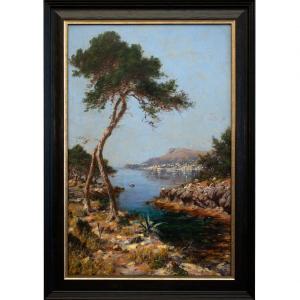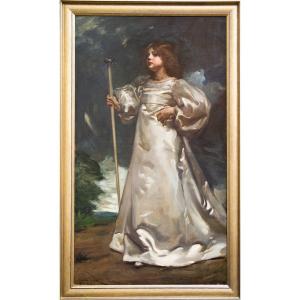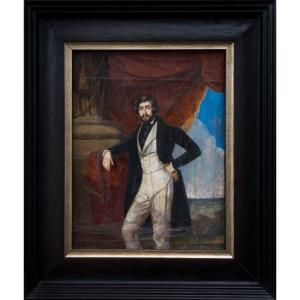Sunset, c. 1875
oil on wood panel
c.1875
signed Severin Nilson
unframed 14 x 19.7 cm (5.51 x 7.76 inches)
framed 24 x 29.5 cm (9.45 x 11.61 inches)
hand made oak frame by Stockholms Förgyllning och Bildhuggeri.
Condition:
The painting has been recently restored by our conservator and is now in a very good condition, with only a few minor retouches. The frame is newly handcrafted by one of Europe's most skilled frame makers Christer Björkman.
Essay:
This painting, most likely created during Severin Nilson’s time in Paris, carries a strong influence from the impressionist movement that surrounded him during his studies under Léon Bonnat. Nilson arrived in Paris in 1873, a pivotal moment in the art world. That same year, Claude Monet painted his iconic Impression, Sunrise, and Camille Pissarro completed his serene work Sunset in 1872. Both paintings, focusing on the natural light and atmosphere of the sky at different times of the day, exemplified the impressionist fascination with capturing fleeting moments, often in the form of sunsets and sunrises.
In this painting, Nilson embraces a similar theme. The vivid depiction of the sun glowing in a hazy sky with the sea gently reflecting the soft colors speaks to a fascination with the subtleties of light, color, and movement. It’s easy to imagine how the impressionist techniques pioneered by Monet and Pissarro would have captivated Nilson, who, at the time, was deep in the midst of Paris’s vibrant art scene.
The layered, almost textured brushstrokes in the painting suggest a departure from strict realism, leaning instead toward the impressionist philosophy of conveying the essence of a scene rather than meticulously recreating every detail. This work reflects Nilson’s desire to explore the interplay between natural light and color, a hallmark of impressionist innovation.
Severin Nilson, who became known for his genre scenes and landscapes, was a prolific artist whose legacy includes a broad range of works, now housed in prominent institutions like the Nationalmuseum and Kalmar Konstmuseum. His time in Paris undoubtedly shaped his artistic vision, and this painting offers a glimpse into his appreciation for impressionism’s revolutionary approach to capturing the world.






































 Le Magazine de PROANTIC
Le Magazine de PROANTIC TRÉSORS Magazine
TRÉSORS Magazine Rivista Artiquariato
Rivista Artiquariato